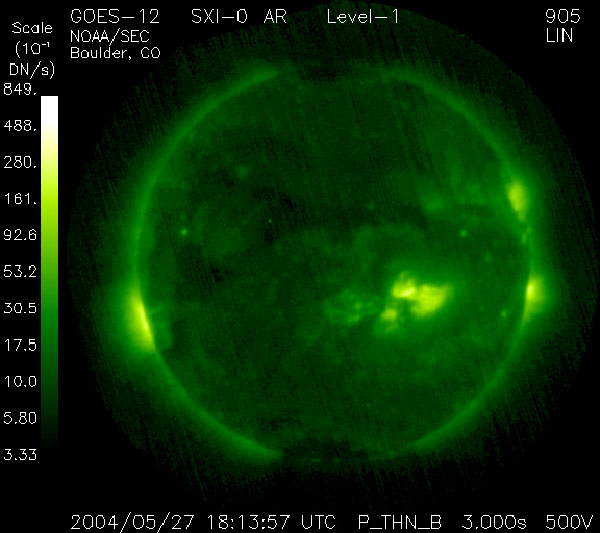By Patrick Barry and Tony Phillips
Radiation storms, 250 mile-per-second winds, charged particles raining down from magnetic tempests overhead ... it sounds like the extreme weather of some alien world. But this bizarre weather happens right here at Earth.
Scientists call it "space weather." It occurs mostly within the gradual boundary between our atmosphere and interplanetary space, where the blast of particles and radiation streaming from the Sun plows into the protective bubble of Earth's magnetic field. But space weather can also descend to Earth's surface. Because the Earth's magnetic field envelops all of us, vibrations in this springy field caused by space weather reverberate in the room around you and within your body as much as at the edge of space far overhead.
In fact, one way to see these "geomagnetic storms" is to suspend a magnetized needle from a thin thread inside of a bottle. When solar storms buffet Earth's magnetic field, you'll see the needle move and swing. If you live at higher latitudes, you can see a more spectacular effect: the aurora borealis and the aurora australis. These colorful light shows happen when charged particles trapped in the outer bands of Earth's magnetic field get "shaken loose" and rain down on Earth's atmosphere.
And because a vibrating magnetic field will induce an electric current in a conductor, geomagnetic storms can have a less enjoyable effect: widespread power blackouts. Such a blackout happened in 1989 in Quebec, Canada, during a particularly strong geomagnetic storm. These storms can also induce currents in the metallic bodies of orbiting satellites, knocking the satellite out temporarily, and sometimes permanently.
Partly because of these adverse effects, scientists keep close tabs on the space weather forecast. The best way to do this is to watch the Sun. The NASA/ESA SOHO satellite and NOAA's fleet of GOES satellites keep a constant watch on the Sun's activity. If a "coronal hole"--where high-speed solar wind streams out from the Sun's surface--comes into view, it could mean that a strong gust of solar wind is on its way, along with the geomagnetic storms it will trigger. And an explosive ejection of hot plasma toward the Earth--called a "coronal mass ejection"--could mean danger for astronauts in orbit. The advancing front of ejected matter, moving much faster than the solar wind, will accelerate particles in its path to near the speed of light, spawning a radiation storm that can threaten astronauts' health.

This image shows the outer solar atmosphere, or corona, as viewed by the GOES 12 Solar X-ray Imager (SXI). It shows the plasma at 4.0 MK (million degrees Kelvin). Bright areas are associated with sunspots seen in white light images and may produce explosive events known as flares. Dark regions are coronal holes where the fastest solar wind originates. Image courtesy of the Space Environment Center/NOAA.
Look for coming articles for more about space weather and about NOAA's
efforts to forecast these celestial storms. Meanwhile, read
today's space weather forecast at
http://www.sec.noaa.gov/.
Kids can learn about the geostationary and orbits of the GOES
satellites at
http://spaceplace.nasa.gov/en/kids/goes/goes_poes_orbits.shtml
.

